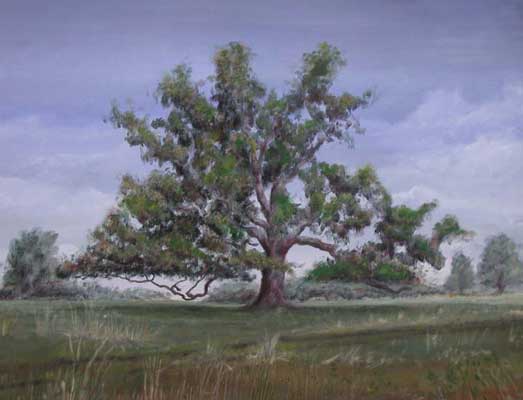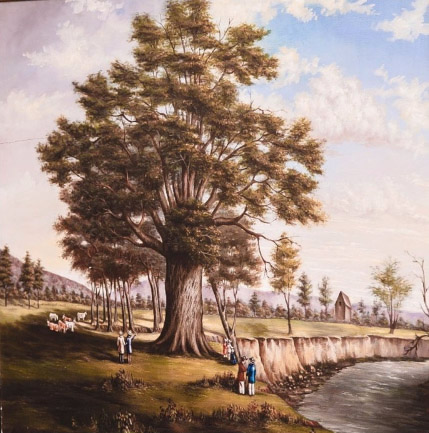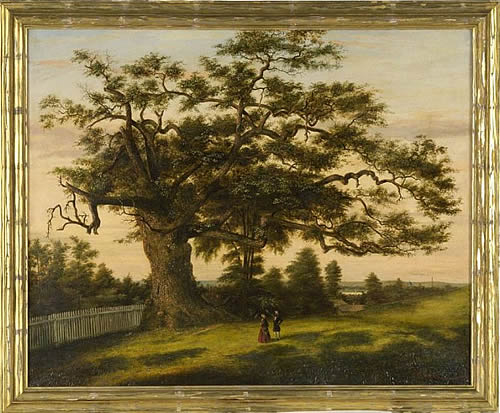
Check out the Geneology Charts at the Wadsworth Institute and how you relate!
Wadsworths and Oak Trees |
|
In the Geneseo area there are many Oak Trees in the open fields. Why they are there are explained in an article published by Terry R. Belke and WGRZ on July 20, 2014. Like distant voices from a forgotten past, the massive trees stand in testament to the history of Geneseo. The gigantic sentinels, mostly Oak trees, tell fascinating stories if only one will learn to listen. One who has is David Robertson of SUNY Geneseo. He, along with colleagues from UB, have been conducting a study on the trees for six years, a relatively short time in the lives of these ancient beings. " We have here in Geneseo likely some of the biggest and oldest Oak trees in the state." They're very well known locally, artists have been coming to Geneseo for a century or more to paint our trees, they are much beloved."The mighty Oaks tell the story of two cultures that despite their differences shared a mutual respect for the trees and over time grew to become their guardians .Robertson explains. " I think it's clear that these trees are old, that they pre-date European arrival, and that these trees grew in open conditions, that this landscape was a used and open space, that these trees are likely artifacts of Seneca occupation, Seneca land use here in the valley, that have subsequently been protected through several generations of land stewardship here in the valley.After the Senecas were forced from their land, much of it ended up in the"possession of James Wadsworth, a local land developer who saw the same sublime landscape the Native occupants did. " They saw the value and beauty of the large Oak trees," said Robertson. " And protected them on their home properties, but also protected them on leased properties through shade tree protection clauses, and this was very progressive sort of agricultural practice for early in the 19th century." The Geneseo Professor says that the land is still revered, protected by descendants of the Wadsworth family, as well as other owners in the area. It's a chronicle that imparts meaning even today. " I think that there's a story to be told about land stewardship, certainly, that's an important one, that we can protect beautiful spaces and important cultural artifacts and natural features like these trees, I think that's an important lesson to draw." |
|
 |
 |
| Painting: "Oak on the Flats" by William S. Wadsworth | Painting: "Oak In The Oneida Lot" by William S. Wadsworth |
The Big Tree of Geneseo, NYThe Genesee Valley was well-settled by the Seneca Indian Nation. During these times, the region around the Genesee Valley was simply called “Big Tree." As European settlers began to lay claim to the land, land rights were negotiated with the Seneca Nation. Talks held on the property of what is now Wadsworth family land culminated in The Treaty of Big Tree in 1797 that created land reservations for the dispossessed Seneca while granting ownership of the land to the Holland Land Company for 3 ½ million acres for development to non-natives. A particularly large oak tree once stood on the bank of the Genesee River. After having been rooted in that original location of witness for many years, the tree fell in 1857 as a result of a great flood. Its last remaining section was housed in an outdoor shelter on the grounds of the Livingston County Museum until 2017. The tree is now exhibited inside the museum. Come see The Big Tree of the Genesee and touch a piece of history! |
 |
The Charter Oak of ConnecticutThe Charter Oak is the official Connecticut State Tree. An image of the celebrated Charter Oak was selected to be emblazoned on the back of Connecticut's state quarter, minted in 1999. What is the story behind this famous tree, gone from the landscape but very alive in significance? In May of 1662, Connecticut received its Royal Charter from England's King Charles II. This important legal document granted the colony its rights to self-government. A quarter century later, King James II's royal representatives attempted to seize the Charter. Well, Connecticut residents were not about to take that lying down, even more so after the Brits threatened to split the state and divide its lands between Massachusetts and New York. On October 26, 1687, Sir Edmund Andros, who had been appointed by the Crown as governor of all of New England, arrived in Hartford to demand the Charter. Nice try. What exactly happened during that evening's showdown at Butler's Tavern may never be ascertained, but the upshot is that, in the midst of heated debates between Connecticut leaders and the royal entourage over surrendering the Charter, the room was plunged into darkness when the candles that illuminated it were overturned. Was it merely an accident, or a crafty maneuver carefully plotted by the feisty defenders of Connecticut's rights? We may never know, but what we do know is that one passionate Nutmegger, Captain Joseph Wadsworth, who was positioned outside the tavern, found himself in possession of the Charter during the ensuing chaos in the darkness. Wadsworth took it upon himself to hide the charter safely inside a majestic white oak tree on the Wyllys estate in Hartford. The stately tree was already more than 500 years old when it served its spectacular role as a hiding spot for the precious document. Wadsworth's bold move served to preserve not only the document but the rights of the colonists.Thus, the tree earned its nickname: the "Charter Oak." The venerable tree stood as a proud Connecticut symbol for another 150 years until it was toppled during a storm on August 21, 1856. Its circumference, by then, was 33 feet. The symbol lives on thanks to the U.S. Mint's state quarters program and state efforts to commemorate the tree. |
|

All Rights Reserved ©2022 WadsworthReunion.org
Keep Informed by Visiting www.wadsworthreunion.org often
Website questions:info@wadsworthreunion.org
